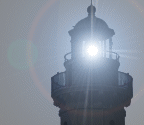IntroductionShort-range navigation aids are installed in coastal waters to support navigation. The position of these installations is fixed and documented in the nautical charts. Therefore, they can be advantageously used as reference and bearing points. Especially during the night time and during periods of reduced visibility, when the coastline is not visible, the light and sound signals of the navigation aids are the primary navigation assistance for the navigator.
Lighted beacons are called lights. Unlighted beacons are day beacons. All beacons may exhibit a day mark of some sort. In the case of a lighthouse, the color and type of structure are the day marks. In the case of buoys and day beacons well-defined geometrical shapes are used. The day mark should allow the identification of the function of the beacon when the color code cannot be determined, due to conditions of reduced visibility - e.g. during dusk or twilight. During the time between sunset and sunrise, lights show distinctive light
phase characteristics by which they can be identified. Knowing their location
from the chart, lights are a great support to the navigator during the
night time, as reference and bearing points. Lights and lager day beacons are described e.g. in the "Admiralty List
of Lights and Fog Signals" published by the United Kingdom Hydrographic Office
(UKHO) or in the "List of Lights" published by the National Imagery and
Mapping Agency (NIMA) and the US Coast Guard (USCG). |
| Cover << Sail Away << Short-Range Aids to Navigation << . | . >> Publications | last updated: 28-Feb-2003 |
